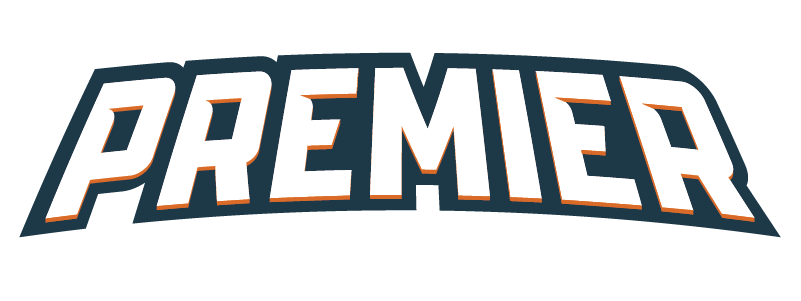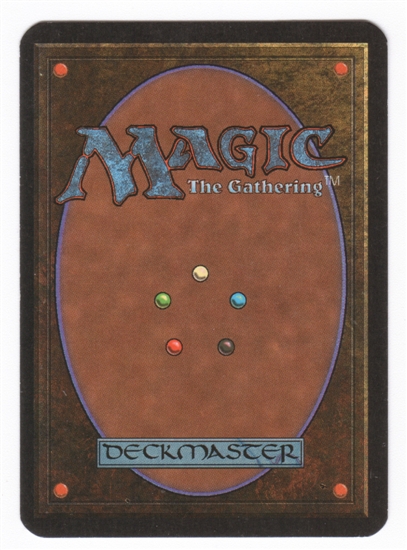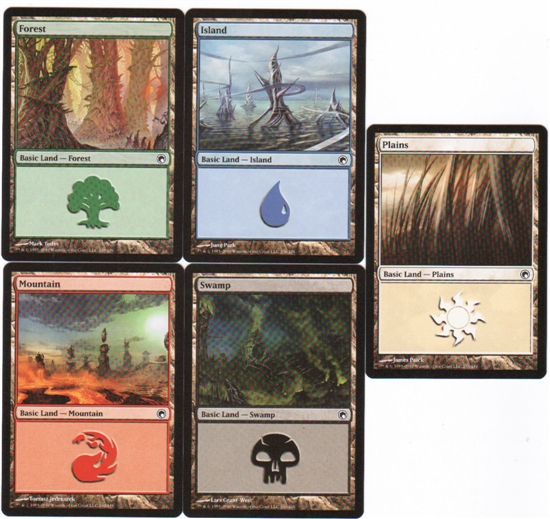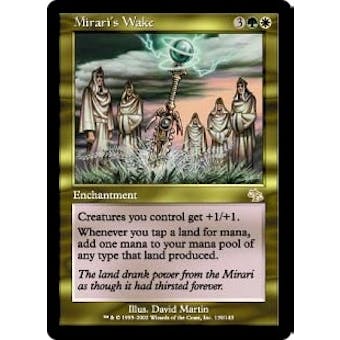
Dave & Adam's Premier Rewards Program
Level Up and Unlock automatic rewards with every dollar you spend
How To Play Magic: The Gathering
Overview
Magic: The Gathering (or MTG as it's also known) is a card game in which two or more players take their collection of cards to the battlefield and fight... to the death.
MTG: The Basics
 To be eligible for gameplay, you must have a deck with at least 60 cards.
To be eligible for gameplay, you must have a deck with at least 60 cards.
The game is made up of three main categories of cards (we'll get into each a bit further in their respective sections):
- Creatures - attack opponent life and block opponent attacks
- Land - provide mana (energy)
- Others - have their own unique abilities (again, we'll talk about this more later)
With 60 cards, it is recommended that your deck be made up of 40% land cards (about 24), 15-25 creature cards, and the remaining spots filled in with spells.
Objective
Each player starts with 20 life. The objective of the game is to attack your opponent until they lose all of their life - this is a fight to death. Plain and simple, once you have decreased your opponent's health from 20 to 0, you win.
Land Cards
Land cards generate mana, the energy of Magic. Land cards are permanent, meaning once they are on the battlefield, they can't be removed. Each land card counts for one mana.
The reason land cards exist is due to the fact that most cards require a certain amount of mana to be activated. The required amount of mana depends on the strength of the card.
 Each turn, you are able to lay down a land card, and as they build up in your battlefield, you can use them to summon better creatures and spell cards from your hand.
Each turn, you are able to lay down a land card, and as they build up in your battlefield, you can use them to summon better creatures and spell cards from your hand.
There are five colors of mana, representing the five different types of energy found in Magic The Gathering. These five colors are:
- White (Plains)
- Blue (Island)
- Black (Swamp)
- Red (Mountain)
- Green (Forest)
Most creatures and spells require a certain amount of a specific color of mana, while others can use any color of mana. Some ask for a combination of colors too. For example, a creature card may need three green mana and also one mana of any color in order to be summoned. And without the required amount of mana, it couldn't be used.
Sample Mana Costs
| 3 mana and 1 Blue | 3 Black | 1 mana and 1 Red or Blue | X mana and 1 Green |
|---|---|---|---|
|
Note: X means any amount of any color mana |
|||
Creature Cards
Creatures are the focal point of the MTG game; they attack and defend. Like land cards, creatures are permanent in the battlefield unless they are destroyed.
As you know, each creature card requires a certain amount of mana to be summoned and activated. This is shown in the top right corner of the card. But once summoned to the battlefield, you must wait until your next turn before you can to attack with that creature. Attacks made by a creature can be directed at your opponent's life or at enemy planeswalker cards (more on these to come).
Each creature card displays two numbers in the bottom right corner. The first number represents the creature's power and the second indicates their toughness. If a creature blocks another creature's attack, these two ratings determine whether a creature stays active or is sent to the graveyard (MTG's term for "discard pile"). A creature is sent to the graveyard if their toughness level is lower than the opposing creature's power level. The power rating also determines the damage done to opponent life and planeswalker cards when attacked. For example, if your opponent has 13 life and you attack with a creature card that has 5 power, their life decreases to 8. Simple math.
Some creatures have unique abilities that can be activated at almost any point in the game, and are described below the picture on the card. They can give you an advantage by boosting the abilities of your cards, decreasing abilities of enemy cards, etc. These abilities cost mana though, so watch out!
Other Cards
There are five other types of cards in Magic The Gathering, each with their own unique abilities that can be used to affect the game and give you an advantage. These cards are:
- Sorceries
- Instants
- Enchantments
- Artifacts
- Planeswalkers
Sorceries
Each sorcery has its own effect described in the text of the card. These cards can only be played during the main phase of your own turn. Once played, the card is discarded and turned over to the graveyard.
Instants
Instants also have their own effect, but unlike the sorcery cards, they can be used almost any time you want. These cards can be played during your turn, during your opponent's turn, or in response to another spell. After it is used, it is immediately discarded and sent to the graveyard.
Enchantments
Enchantment cards are slightly different than sorceries and instants because they are permanent in the battlefield. Once activated, these cards must be destroyed before they can be discarded.
Some enchantments are called "auras." What the heck does that mean? Simply put, auras are enchantments that attach to other permanent cards in the battlefield. If the enchanted card leaves the battlefield, so does the aura.
Artifacts
Like, enchantments, artifacts are permanent in the battlefield unless they are destroyed. What's unique about artifacts is that most are colorless, meaning you can activate them with any color of mana.
Some artifacts can be used as equipment, which then attach to a creature card under your control and boost its abilities (of course, this costs extra mana). If the equipped creature leaves the battlefield, the equipment is dropped, but stays in the battlefield.
Planeswalkers
Planeswalkers are different from other cards. They contain a number in the bottom right corner of the card which represents their "loyalty." Loyalty can mean several different things depending on the situation. Planeswalkers can be attacked by creatures and their loyalty score can function similarly to a creature's toughness score. But Planeswalkers also have a list of special abilities within their description, and each ability comes with an attached positive or negative number. This number is then added to or subtracted from their loyalty score. As abilities are used, the loyalty score acts as a running balance.
Confused? Don't be. If you use an ability with +1, the Plansewalker's loyalty score increases by 1. If you use an ability with -4, you lose 4 loyalty. What happens if you only have 4 loyalty in this case? The card will be sent to the graveyard.
For the record, you can only choose one ability to use each turn.
Game Zones
No matter how much you know about the cards in Magic: The Gathering, you can't even begin to play without knowing about the game zones:
- Library - your deck of face-down cards that you draw from. No player may look at another player's library.
- Hand - the selection of your cards that have been drawn from your deck. These are the cards you can actually put into play. The maximum amount of cards you can hold in your hand is 7. If a hand ever has more than 7 cards, the holder of that hand must choose which cards he/she would like to discard before the turn is over. Or else!
- Battlefield - where permanent cards (land, creature, etc.) are summoned and activated
- Stack - where spell cards and abilities are activated. Players can respond to each other's spells and abilities by placing new spells or abilities on top of the stack (it's allowed to do so multiple times in the same turn). The last spell or ability to be placed atop the stack is activated first. Spells in the stack are resolved in order of how recently they were played. Players get a chance to add to the stack after each resolved spell or ability.
- Graveyard - you know this one! It's the discard pile.
- Exile - certain spells can exile cards; those cards are brought here. This is a zone shared by both players.
Tapping & Untapping
Tapping and untapping is another essential concept to the game. Tapping a card simply means to tilt it 90 degrees to the right. This is a necessary step if you want to use a land card to make mana, attack with a creature, or activate abilities with the tap symbol as a part of the cost.
Cards must be untapped before they are used again. Cards are untapped at the beginning of your turn. Therefore, if you tap a card, you must wait until it is back to your turn so you can untap it. Once it is untapped the next turn, you are free to use the card again.
Now You May Begin! But How?
If the two players haven't played each other before, a coin flip decides who has the first move, but if they have played previously, the loser of the last game goes first. Both players will then shuffle their decks, draw 7 cards, and begin.
Gameplay
Magic: The Gathering is a turn-based game. A turn consists of 5 phases:
- Beginning Phase - players untap any tapped cards, trigger any "once per turn" effects, and draw a card.
- First Main Phase - allows you to play a land card and cast any non-land cards. It also gives your opponent the opportunity to cast instants and activate abilities.
- Combat Phase - declare attackers, declare blockers, calculate and apply damage.
- Second Main Phase - cast spells, activate abilities or play a land card (if you didn't during the first main phase). Again, your opponent can cast instants and activate abilities.
- Ending Phase - discard any extra cards. Any damage done to creatures (still active in the battlefield) is removed.
After these phases are complete, the turn ends. It is then turned over to your opponent and the process is repeated. Once your opponent's turn is finished, he then turns it back over to you. This process continues until a player loses all 20 life.
And that, in a nutshell, is how to play Magic: The Gathering. Wanna play? Head over to our gaming section and shop our huge selection of MTG cards!
Want to play?
Here's a few products that will help you get started:
 1-888-440-9787
1-888-440-9787
 FREE Shipping on orders $199+
FREE Shipping on orders $199+
 FREE Gifts with orders $100+
FREE Gifts with orders $100+

 Baneslayer Angel
Baneslayer Angel Idyllic Tutor
Idyllic Tutor Hero's Downfall
Hero's Downfall Mirari's Wake
Mirari's Wake Mox Diamond
Mox Diamond Jace, the Mind Sculptor
Jace, the Mind Sculptor Magic Journey into Nyx
Magic Journey into Nyx